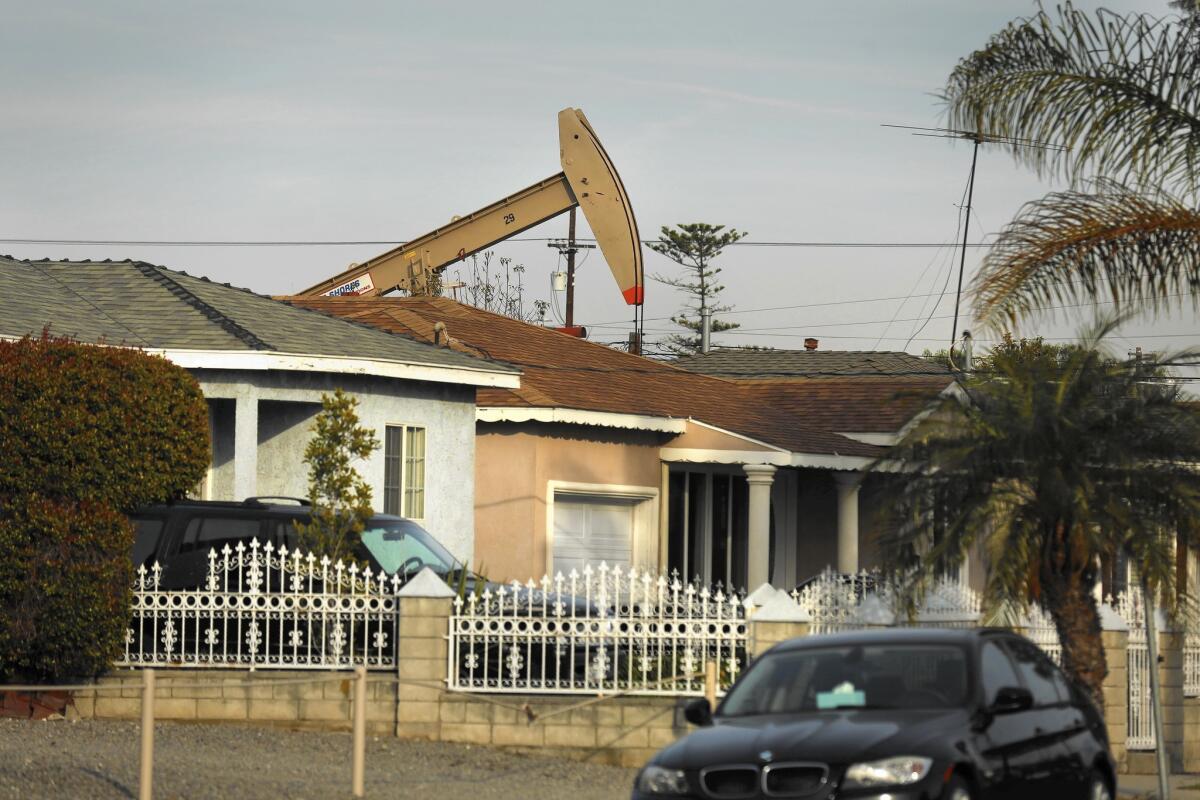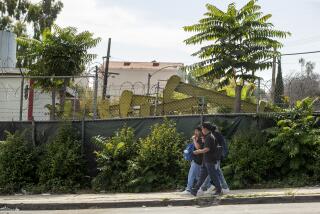After 10 years, neighbors of a Wilmington oil drilling operation still complain of health, environmental issues

A decade ago, Los Angeles city planners gave an energy company permission to drill up to 540 wells and produce up to 5,000 barrels of oil a day on a Wilmington site next door to a youth baseball field and blocks of homes.
The next few years were, in the words of one neighbor, “a living hell.” People living nearby complained of foul odors, gas flaring, oily dust, round-the-clock noise, diesel truck traffic and foundation-damaging vibrations. They said the fumes made them nauseous, gave them headaches and itchy eyes.
------------
FOR THE RECORD:
Wilmington oil field: A photo caption in the Feb. 21 California section with an article about a Wilmington oil field misspelled the name of Elficer Garcia as Elcifer. It also said Garcia lives next to a Wilmington oil drilling site permitted for up to 540 wells. Garcia lives in another Wilmington neighborhood, next to an oil pump jack and several storage tanks. —
------------
In response, the regional air quality board issued orders to stop the flaring violations. The planning department imposed some new conditions — and reiterated its support of the drilling.
“In a time where dependence on foreign oil comes at an increasingly higher social, economical, political and human cost, it can be found that this approval, by encouraging and facilitating local oil production, under strict controls .... will be of direct benefit to the general public convenience and welfare,” wrote the associate zoning administrator overseeing the project review.
Working-class, minority neighborhoods in Wilmington and South Los Angeles have been plagued for years by foul odors, noise and dirt from oil operations that are practically in their backyards. But residents and activists argue that officials’ response to those problems has been slow and woefully inadequate.
Those feelings have only been heightened since the gas leak in Porter Ranch, an upscale San Fernando Valley community.
The leak was so large that it forced thousands of residents from their homes, with some complaining about nosebleeds, headaches and nausea. Within weeks, the gas leak had become a cause celebre for elected officials. Southern California Gas Co., which operates the well that was the source of the leak, covered the costs of residents’ temporary relocation to motels and rental housing.
Activists say they don’t begrudge the attention heaped on Porter Ranch but wish the problems in their neighborhoods had gotten a similar level of attention.
Residents in South L.A. and Wilmington “are subjected to similar emissions and compounds, such as carcinogenic benzene in addition to deadly chemicals such as hydrochloric acid trucked through and pumped in their neighborhoods,” said Gladys Limón, a staff attorney with Communities for a Better Environment, which represents groups that recently filed a lawsuit challenging city approvals of oil drilling in minority neighborhoods. “Yet those residents have not had similar hearings, no one has offered relocation assistance. There’s been no medical monitoring and no one has called into question the very practice of neighborhood drilling.”
Advocates point to problems at the AllenCo Energy site in South L.A. and the Exide Technologies contamination. Exide’s battery recycling plant in Vernon spewed toxic lead dust into Huntington Park, Boyle Heights and other neighborhoods for decades, possibly contaminating the yards of as many as 10,000 homes before state regulators moved to close the facility and launch a cleanup that residents complain has been slow and underfunded.
And it took three years and hundreds of complaints about fumes and air pollution from ramped-up oil production at the AllenCo site before the U.S. Environmental Protection Agency launched an investigation in 2013 and the oil company halted drilling operations.
Officials say their handling of the Porter Ranch leak was justified by its enormous scope and duration. “It represented much more of an acutely urgent situation” than continual, low-level exposures in other communities, said Dr. Cyrus Rangan, medical toxicologist with the Los Angeles County Department of Public Health.
Barry Wallerstein, executive officer of the regional South Coast Air Quality Management District, drew a similar distinction. “It’s not proper to compare a massive, ongoing natural gas leak that has in it mercaptans and other pollutants potentially of concern to periodic releases that occur at an oil field.... They are a different magnitude in scale.”
The district took community complaints about the Wilmington facility seriously, Wallerstein said. “I spent considerable time on this issue. My staff spent time. I went out at the time of the complaints and visited the neighborhood. I have been back since.”
L.A. planning officials declined to comment, citing the oil drilling lawsuit.
Manuel Pastor, director of USC’s Program for Environmental and Regional Equity, said the complaints from Wilmington and South L.A. residents speak to the environmental inequities that have long plagued Los Angeles.
He attributed them in part to historic land-use patterns. The L.A. Basin population exploded as the region grew into a hub of freeways, manufacturing and oil production. But Pastor also said that polluting industries locate in poor minority communities not just because land is cheaper, but because they can expect fewer political hassles.
Many living in L.A.’s minority neighborhoods don’t own their homes or have a strong command of English. Some are in the country illegally, making them reluctant to register official complaints.
When Warren E&P Inc. bought the Wilmington operation on East Anaheim Street in 2005, nine active oil wells operated on the 10-acre site, which had been producing oil since the 1930s. To increase production, the company proposed using directional drilling techniques to burrow thousands of feet under the surrounding residential and industrial areas.
Without conducting a full environmental review of the project, the L.A. planning department gave Warren approval to drill, over a dozen years, up to 540 wells on the lot, on the condition that the company phase out 56 of the hundreds of oil wells scattered throughout Wilmington.
“I was given the impression that this would remove the oil wells that had really dotted Wilmington and replace it with one operation, slant drilling, and they were going to build these pocket parks all over,” said Rep. Janice Hahn (D-San Pedro), who at the time represented Wilmington on the L.A. City Council and supported the project. “It was an appealing alternative.”
Then the drilling started.
Sylvia Moreno, 57, bought her house on nearby Lecouvreur Avenue in 1991. “It was quiet until the [drilling] tower went up,” she said. “Nobody knew what was happening until the houses started shaking.”
During heavy drilling, windows rattled, pictures fell from walls and cracks spidered through plaster. Before a pipeline was built to a local refinery, oil trucks rumbled through the neighborhood, making 40 to 60 trips a day. Nighttime production work jarred neighbors awake with clanging pipes and machinery. Thick, black dust coated cars and furniture. Odors likened to fish and rotten eggs wafted into homes, leaving nausea and headaches in their wake.
Sophia Romero, 28, said her respiratory problems worsened after she and her mother moved across the street from the Warren site 10 years ago. She developed a chronic cough that at times was so bad she spit up blood and had to go the emergency room.
“I’ve had a collapsed lung twice,” Romero said. When the drilling first started, the rotten-egg smell in the tap water was so strong that the Romeros didn’t drink it and plugged their noses while showering.
After neighbors took their complaints to Hahn’s office and Limón’s organization, the city reopened the zoning case in 2008. The air quality board found Warren in violation of its gas flare permit and issued an abatement order.
Warren handed out car and window washing coupons and paved the production area to cut down on dust. Hahn — who said she no longer believes such a big drilling operation is appropriate near homes — says the company also installed double-pane windows and air filters in some adjacent houses.
But the city allowed Warren to continue drilling and production activities 24 hours a day, seven days a week, including holidays. Requests that the company be required to pay for independent noise, air and vibration monitoring and water sampling in the neighborhood went unheeded.
Last year, Warren pumped 2,500 to 3,000 barrels of oil a day at the site. To date, the company has drilled about half its permitted wells. Given slumping oil prices, it has no plans to drill more any time soon, said Dan Collins, a vice president of Warren’s parent company.
Neighbors say the noise and emissions aren’t as bad as they used to be. But they still have problems.
“My daughter just developed a rash around her eyes,” said Jennifer Castillo, 27, showing photos of the 7-year-old with puffy eyes. “She likes to ride her bike up and down the street. I took her to the ER. The doctor said it was caused by some airborne toxin irritating her skin.”
Recently, Castillo said, Warren workers were dropping pipes and making enough noise to keep the entire neighborhood awake.
Her daughter’s father went to tell them to keep it down. “They said they had a permit. They gave him a number to call but the number was invalid,” she said.
The John Mendez Baseball Park is part of the Warren lot, separated from the oil operations by a screened fence and some trees.
“We’re forced to come here. We have no place to play,” coach Leo Patino explained as his team, the Barracudas, fielded practice balls in the shadow of a 100-foot-tall drilling rig.
Sometimes the boys get nosebleeds, and they smell fumes “all the time,” he said. “That egg smell, it is really bad.”
Twitter: @boxall
Twitter: @joemozingo








